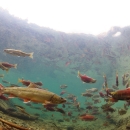In response to a general decline in abundance across their native range, Bull Trout (Salvelinus confluentus) were listed as threatened under the Endangered Species Act in 1999. Gaining a better understanding of the reproductive component of a population is important for Bull Trout recovery and persistence. Accurately monitoring the trend in abundance of spawners is essential to inform future management actions that may affect populations in the North Fork Lewis River subbasin. To estimate the abundance of the adfluvial Bull Trout spawning population, a resistance board weir and underwater video system were operated on Cougar Creek, a tributary to Yale Reservoir on the North Fork Lewis River, from July 15, 2021 through October 31, 2021. A total of 66 observations of adults moving upstream through the weir were recorded from mid-July through late October, with the peak occurring in late-September. The majority of Bull Trout observed were relatively large, migratory fish. However, smaller migratory adults and subadults were observed as well. Since an individual could pass the weir multiple times during the spawning season, the number of recorded upstream observations may have been an overestimate of the true population size. To address this concern, we used PIT tag detections in addition to a photo-identification technique to allow recognition of individuals based on natural marks, such as colors, spots, scars, and fin shapes and to estimate the number of individuals that passed upstream of the weir. The estimated total number of spawning Bull Trout in Cougar Creek during 2021 was 42 (95%: 35 – 47) unique individuals. The estimated number of males and females in the spawning population was 28 (95%: 22 – 33) and 14 (95%: 11 – 15), respectively. These data, combined with a redd count of 19 during 2021, suggest a spawner/redd ratio of 3.8. However, redd count accuracy was negatively influenced by the onset of high flows in late October. In future years, additional PIT-tagging efforts and improved PIT tag detection capability should further improve population estimates.
Publication date
Type of document
Annual Report
Facility
Program
Species
FWS Focus
FWS and DOI Region(s)





